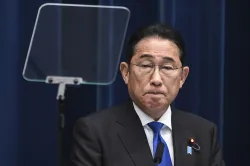Japan all set to pick its next Prime Minister: Who could succeed Fumio Kishida?
Japanese Prime Minister Fumio Kishida announced to step down as prime minister next month, after a three-year tenure marked by scandal and declining public support. Here are some possible contenders to replace him when his ruling Liberal Democratic Party (LDP) holds a leadership poll.

Japanese Prime Minister Fumio Kishida said on Wednesday he would step down next month, a move that sets off a scramble among would-be successors to replace him as head of the world's fourth-largest economy. "Politics cannot function without public trust. I made this heavy decision thinking of the public, with the strong will to push political reform forward," he said in a press conference to announce his decision not to seek re-election as the Liberal Democratic Party (LDP) leader.
Why is Kishida stepping down?Kishida has been prime minister for almost three years, a relatively long tenure in modern Japanese politics. Yet his administration had become unpopular due to a slush fund scandal and controversy over the ruling party's connection to the former Unification Church. The economy also hurt his popularity. Households were battered as price increases outpaced pay rises. For months, public support for Kishida and his cabinet languished below the 30% in opinion polls that are typically seen as a trigger for new elections or leadership change.
What happens next?Under Japan's parliamentary system, the leader of the ruling party, or coalition of parties, becomes prime minister. For almost all of Japan's post-World War II history, that has meant the premier has hailed from Kishida's Liberal Democratic Party (LDP). The LDP must hold a leadership race every three years. The next one is due to be held in September although the dates have yet to be set.
Who could succeed Kishida?Candidates need 20 signatures from LDP parliamentarians to run for leadership of the party. Former Defence Minister Shigeru Ishiba and former Foreign Minister Toshimitsu Motegi are among those seen as frontrunners. Other names that have been floated as potential contenders include Foreign Minister Yoko Kamikawa, Digital Minister Taro Kono, and former Environment Minister Shinjiro Koizumi. Experts say that the LDP will have to pick a fresh face that breaks from the scandals that have mired the party recently to survive a general election, which is due by the third quarter of 2025 at the latest.
"If the LDP picks its next leader in a way that disregards public criticism against political funding scandals, the party could suffer a crushing defeat," political analyst Atsuo Ito said. "The party must choose someone young who has no ties with the present administration and thus can present a new LDP," he added.
How does the vote work?Each LDP member of parliament will get a vote, and a similar number of votes will be apportioned among rank-and-file members of the party at large. The LDP currently has 369 lawmakers in the upper and lower houses of parliament, based on the party's website, while registered party members numbered about 1.13 million during the previous election in 2021. The votes cast by party members will be tallied according to a proportional representation system called the D'Hondt method. If no one wins a majority of the votes in the first round, there will be a run-off vote between the top two candidates.
How will the next administration be formed?Once a new LDP leader is elected, parliament will be called into session to elect the next prime minister. The candidate who wins the majority of votes cast by the lower and upper houses of parliament will take the top job. Given the LDP's majority in both houses, the LDP leader will likely be elected as prime minister. The new premier is also expected to form a new cabinet and reshuffle the LDP party executives in early October.
(With inputs from agencies)
ALSO READ: Japan Prime Minister Fumio Kishida to step down amid series of scandals, not to run for re-election